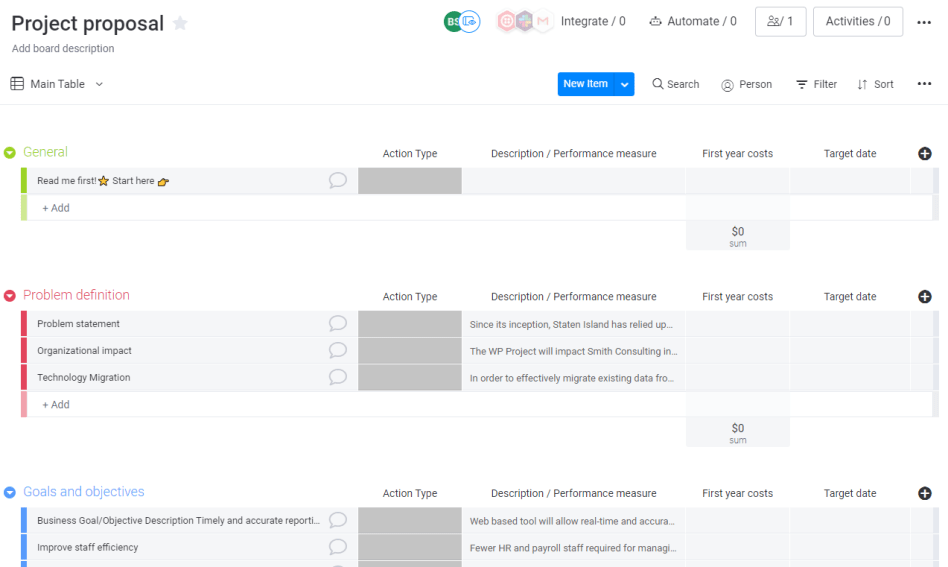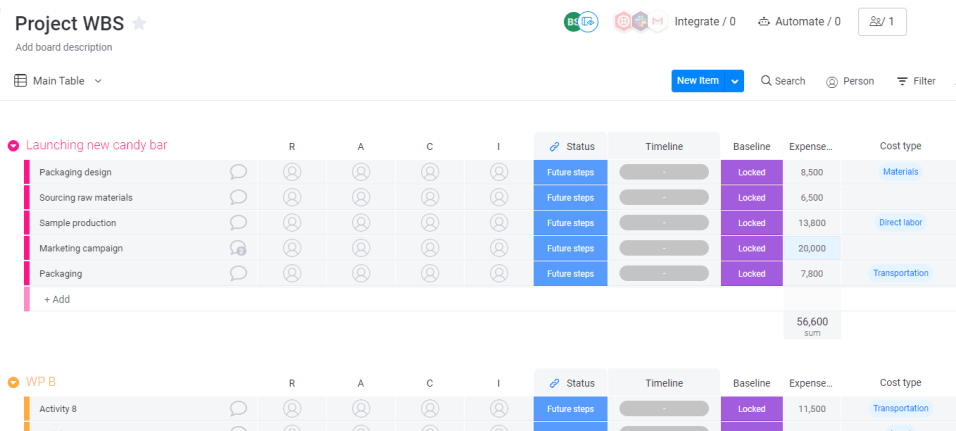With Agile, Lean, and all the other new cool kids on the project management block, some managers act as if there’s nothing left to learn from traditional project management.
They may act as if traditional project management is a useless relic from a bygone age — the pager of the modern era. But that’s just not the case. Most modern methodologies and frameworks build upon tried and tested concepts that existed decades before the advent of software development or the internet.
Traditional project management’s established methodology views projects as being run in sequential cycles. The fixed sequence of initiation, planning, execution, monitoring, and closure still offers much to learn for a modern project manager or a business owner.
In this article, we’ll cover traditional project management, essential concepts, benefits, and drawbacks, see how it compares to Agile, and explore the best use cases for each.
What is traditional project management?
Traditional project management is a step-by-step predictive approach to project management—also called the Waterfall methodology—in which you break down and plan an entire project before launching it.
Processes in the requirements stage help you predict and manage risks. And by getting the brunt of planning done up front, you can get out of the way and let your teams focus on actually doing the work.
It doesn’t refer to a specific framework but rather a high-level methodology or set of ideas for managing your project.
Traditional project management life cycle
In the traditional Waterfall method, the project life cycle follows the following stages in sequential order.
- Initiation: pre-planning phase where you explore the requirements, scope, risks, benefits, and whether or not a project is realistic.
- Planning: figuring out logical project teams, dividing the project into smaller work items, and creating the project schedule.
- Execute: taking the project plan and putting it into action, making the project a reality.
- Monitor: checking that the project is on the right track and adjusting plans, teams, and activities where needed.
- Close: finishing up a project, reviewing the entire project for lessons learned, and planning any updates or replacements of old products.
These process groups guide you through the different stages of the traditional method.
What is the main challenge in the traditional project management approach?
The biggest challenge with traditional project management is effectively adapting to changes during a project.
Unforeseen changes play a crucial role in over 33% of project failures. As markets and organizations change, projects need to as well.

But that’s a lot easier said than done. When project objectives change, you then have to restructure teams, workflows, milestones, and the entire plan. It’s a major issue.
It’s also time-consuming and difficult to plan or gather requirements for large-scale projects before you even get started.
That can lead to teams losing their patience, taking shortcuts, and starting a project without laying the proper foundation. In a traditional model, the initial plan is crucial for project success.
Advantages of traditional project management
But that’s not to say that there’s no upside to the traditional method of project management. It also has unique advantages and specific use cases where it makes more sense.
1. Control unchecked scope and cost creep
While empowering your employees to manage themselves is crucial for productivity, they need a framework to keep them on track with the project.
An in-depth, high-level plan with clear milestones can keep teams accountable and focused on the objectives that matter.
Small decisions the project team makes in the day-to-day is what shapes the final project. If your upfront planning is solid you can eliminate unchecked scope creep.2. Perfect match for flawless workflows
The traditional methodology may not be the best for unpredictable, complex projects, but it’s the perfect match for flawless operations.
If you can’t afford to take a new product live with any flaws, you can map out an entire process with multiple checks and balances to make sure you don’t break an SLA or end up with a faulty product.
3. Manage and minimize risks
Avoid falling into the trap of sunk costs by identifying all major risks before even getting started. Could the new product or service damage your positioning in the market? Would investing in this area take crucial funds away from a more vital project?
With the traditional approach, you can stay on top of risks like these.
4. Perfect for projects with limited unpredictability
For projects and processes your company is used to with limited unpredictability, like creating a new website, there’s no problem with planning everything beforehand.
Traditional vs. Agile project management
So when it comes to traditional vs. Agile, which method is better? Let’s start by looking at the differences in the workflow.
What is the difference between traditional and Agile workflow?
The main difference between a traditional and an Agile workflow is the timeframe. With a traditional workflow, you plan the entire project from start to finish.
With Agile, you typically break down the project scope into iterations lasting 2–8 weeks:

At the end of each iteration, you can take any new insights and use them to adjust your course for the next iteration.
This flexibility is the essence of what makes Agile methodology so popular. For complex projects with a lot of unpredictable factors, constant course adjustments are necessary.
Which is better, traditional project management or Agile?
Unfortunately, there’s no clear-cut best choice between traditional and Agile project management.
It depends on…
- Your industry
- The complexity and scope of your project
- Your workflow
- The product, service, or another goal of your project
Even though most companies are at least experimenting with Agile frameworks, there’s a reason why managers still use traditional methods for over 50% of projects.

Sometimes traditional is the best fit.
- Choose Agile for projects that do not need a rigorous timeline with a high degree of unpredictability.
- Choose traditional when the timeline needs to be predictable for efficient resource usage, like a construction site.
Principles that transcend the “traditional” box
If your team or company is making the switch to Agile, it’s common to try to wipe the slate clean and start fresh.
Of course, some of the values and ideas are at odds with traditional management principles. But not all of them.
Many of the principles of traditional project management highlighted in the PMBOK (Project Management Body of Knowledge) are still useful in an Agile workflow.
- Risk management: switching to the Agile approach doesn’t mean you should forget about risks. You still need to evaluate projects before you get started.
- Stakeholder analysis and engagement: if anything, stakeholder analysis is more crucial with Agile. You engage them throughout the project, not just during initial planning.
- Project communications management: with Agile, a solid framework for communications is even more vital.
How to find and use the right method for every project
Project management is challenging enough when you only need to stick to a single method. But that’s a recipe for inefficiency.
You should handle each project with a method and framework that suits its scope and needs.
Evaluate the complexity and scope of your projects.
Before you even start a project, you need to figure out the objectives, risks, and scope of the undertaking.
Define the problem you want to solve, identify minor objectives, risks, and start outlining the scope of the project.
To speed up this process, you can use the monday.com project proposal template.

The digital format makes it easy to collaborate with relevant departments and outside stakeholders, not just an in-person project team.
Map out deliverables and dependencies.
One of the easiest ways of doing this is to use the work breakdown structure (WBS) from PMBOK.

You can divide a complex physical product into multiple parts or break down the key deliverables of a larger project.
Once you’ve mapped out the moving pieces, you can work to figure out their dependencies.
If the individual pieces are heavily dependent, they could benefit from a rigid timeline. That means the traditional project management methodology is the best choice.
If the pieces are independent of each other, smaller, more Agile teams may deliver better results.
Use a plug-and-play template to get a head start.
Once you’ve made your choice, you can get a jump-start by using an appropriate template for your project.
If you decide to go with an Agile workflow, you can use our iteration template to start planning your first iterations.

By default, it includes status, priority, epic, and duration fields. But you can easily add extra columns or edit labels to suit your workflow.
Customize the template to suit your workflow.
Add, edit, or remove status labels to match your workflow. For example, you might want to add a client review stage if you’re a design agency.

You can also add columns like files, multiple assignees in different roles, time tracking, locations, timelines, or resources.
And it doesn’t end there. monday.com also offers a wide range of integrations and automations to make your workflow smarter.
Immerse yourself in better project management practices
Just because an idea is old doesn’t mean it’s not good or relevant in the digital age. The best project managers have both traditional and Agile methods in their management toolbox.
If you’re looking to break down and manage your project with traditional project management, try our project plan template.


